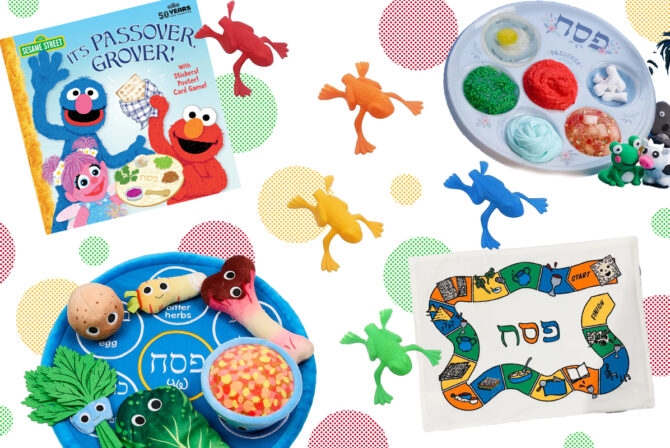Dear Gefilte,
I have a hypothetical question for you. My wife and I were having dinner with some friends the other night who had recently welcomed a new baby into their lives. During the conversation, it came out that the child had been born after a process of embryo adoption, where an embryo from another couple, completely genetically unrelated to either of our friends, had been implanted in and borne by the mother for a full nine months.
Now, this couple wasn’t Jewish, so not an issue for them, but what immediately sprang to mind for us was if this couple had been Jewish, what would the Halakhic (Jewish legal) status of the child be at birth? Under Jewish law, who would count as the mother in this situation—the woman who provided the genetic material, or the one who had done all the work? So if a child of completely non-Jewish genetic origin was carried by a Jewish mother, would that child be considered Jewish at birth? Life has sure gotten complicated.
Thanks,
Overwhelmed by Modernity
READ: Yes, There’s a Cross in My Jewish Home. Here’s Why
Dear OBM,
Mazel tov on your friends’ new life and on your awesome use of the word “borne.” I mean this sincerely—I am a sucker for anyone who uses spelling bee words and makes them hip. Also, thank you for giving me an excuse to contact a few of my favorite rabbis about halakhic law. There are not many things in this world that I like more than chatting with a rabbi over a bowl of popcorn.
In terms of Official Halakhic Status for this would-be baby, here is the good word from Rabbi Ysoscher Katz, Director of The Lindenbaum Center for the Study of Halakha:
Halakha is still sorting out its opinion on these issues. The science is relatively new, it will be a long time before halakha will reach a consensus on these questions.
Rabbi Jeffrey Sirkman, of Larchmont Temple adds:
The “halakhic line” is that a child born of not Jewish parents must undergo immersion in the mikvah, witnessed by a Rabbi/Beit Din [three Jews who are not related to the kid]…For us as Reform Jews, Mikvah is not nearly as essential as a supportive, embracing Jewish family who will show by example and inclusion the warmth and sweetness of all Jewish living and doing can mean.
Now, here’s your Gefilte answer. (Halakhic credentials include but are limited to: went to Hebrew school; had a bat mitzvah; once made a half-way edible kugel.)
READ: The ‘Only Jew at the Dinner Table’ Feeling
I am so thrilled that you asked this question and even more thrilled that there is no definitive answer. I think Watson and Crick would be thrilled, too. Not to mention Pauling, Wilkins, and a brilliant scientist named Rosalind Franklin who never got the credit she deserved for her work in studying our genetic make-up.
DNA provides us with so much incredible information about our freckles and lactose intolerance. Here are some recent advancements in genetic sequencing and research that are revolutionizing our world in a hopeful way:
–New, effective cancer treatments that are personally tailored to each patient according to his/her genome sequence.
–Seidman Laboratory, led by doctors Christine and Jonathan Seidman at Harvard Medical School. This lab is filled with phenomenal minds and mice who are uncovering the intricate ways genes mutate. They are helping people like Joselin Linder save her family’s life.
-My kick-ass 6-year-old friend who I’ll disguise with the name C-dawg. He knows who he is. He also knows that he was born with cystic fibrosis and because of the amazing work being done with genetic research, he is strong, active, and has taught me how to roast potato chips over a menorah flame this past Hanukkah.
I have had some close encounters of the DNA kind myself. My family is hearty and loves a good sing-along, but we carry our fair share of disease material too. I won’t name names, but one of my parents set me up with polycystic kidneys and the other carried blueprints for a rare disease involving partial paralysis. Oy vey schmear.
So one Saturday, after my mom and I looked for training bras that would fit my non-existent-but-sorely-required 15-year-old bosoms, we went to a lab and got our blood drawn. They took a few vials from each of us, offered me a Nilla Wafer, and promised to call with our genetic results in a week or two. To be honest, I was much more concerned about my inherited sequencing for a small rack and moles on my neck than any possible illness. And when the lab called, the verdict was that I was clear from the partial paralysis and needed to get regular sonograms to watch my kidneys.
READ: Teaching My Son to Be a Mensch Through Music
Fast forward two decades, to a sonogram on my uterus with a little flickering heartbeat inside. After giggling, crying, eating three bottles of olives, and crying some more, I went with Mr. Gefilte to do some genetic testing for our hopeful child-to-be. I don’t know if you’ve read those pamphlets in the OB/GYN office lately but the list of horrific inherited diseases is getting longer and more horrific every day. Which, again, I know marks progress in our understanding of DNA, but it’s still scary as hell.
That blood draw was quicker and the results came back faster. I, being the Jewess of hearty but checkered past, brought along a handful of genetic markers for disease. Mr. Gefilte, being a nice lapsed Catholic with freckles, pretty much canceled out our baby’s risks. He told the doctor, “All my family has is alcoholism and misplaced anger.”
We both quit booze right after that meeting.
OBM, I know this is a lot of disease talk and you didn’t ask about percentages for Tay-Sachs. But I think it’s important to see what DNA can determine and what it cannot. I don’t think you are personally trying to define this hypothetical child as Jewish or not. And I’m so grateful that Rabbi Katz said the jury is still out on Halakhic Terms of Agreement. This is such a great opportunity for us to celebrate the open space of unknowing. Please remember even halakhic law is one person’s (or committee’s) point of view.
We—meaning humans and gefiltes—spend far too much time making rules about who belongs where. We wage wars based on the idea that one belief or skin color or nose size is superior to another. Battles in Syria, Myanmar, and Ferguson, Missouri are just a few recent reminders of our obsession with separating ourselves from each other.
OBM, I applaud you for bringing this up and inadvertently lifting me onto my soapbox because I think any level of inquiry is a sign of awakening. We have come so far in so many ways—this week’s celebration of Dr. Martin Luther King, Jr. is a prime example.
And yet we have so much more work to do to create universal acceptance. DNA and genetic research can help us grow stronger physically for sure. But spiritual, philosophical, emotional growth has to start in our hearts.
READ: How Can I Raise My Kid Jewish When I’m Not Religious At All?
By Gefilte Laws, your friends’ child, and any hypothetical child, is beautiful, whole, miraculous, and unique. It’s our job to make that loud and clear.
With love and schmaltz,
Gefilte
Have a question for Gefilte? Send it to deargefilte@kveller.com, and you might just get an answer.







